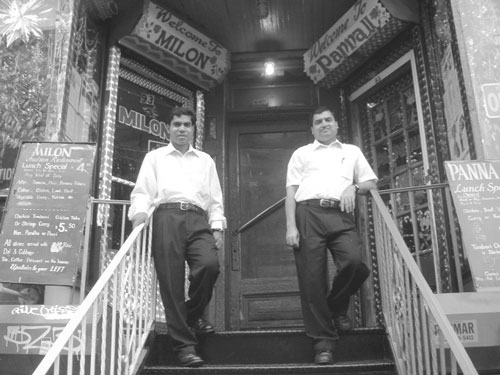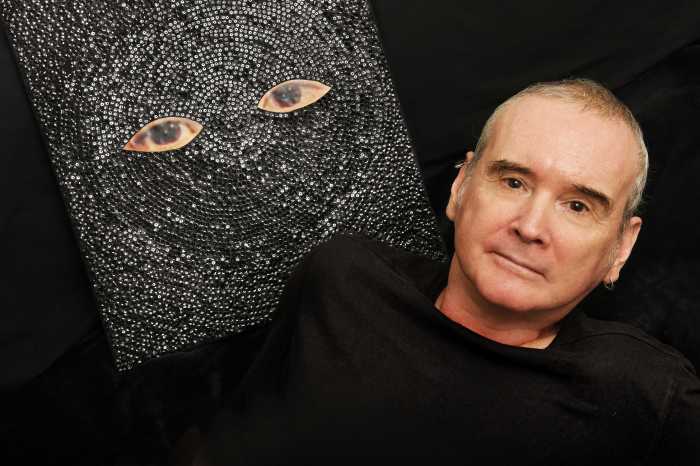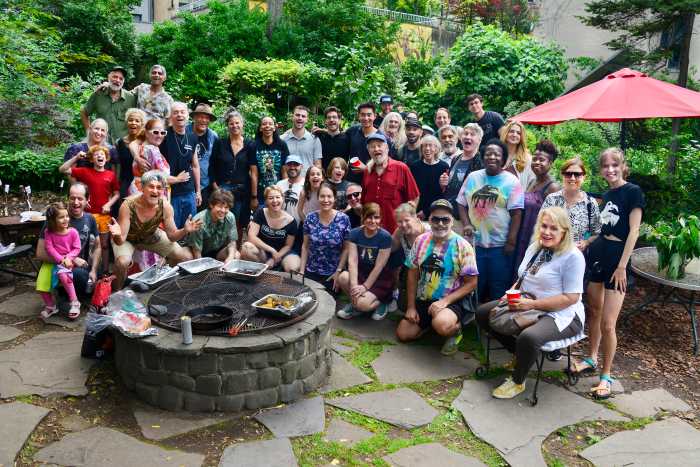By Annie Karni
Shaheed Ahmed, manager of Milon, and Boshir Khan, manager of Panna II, vie for the same customers seven days a week.
Photo by Annie Karni
Aside from their names, little separates Milon and Panna II, the two boxcar-shaped dining rooms on First Avenue between Fifth and Sixth Streets. Their ceilings and walls are buried under thousands of porny red Christmas lights and chili pepper lanterns, which glow from their front and only windows. They both feature $4.95 curry masala lunch specials, BYOB policies, and pineapple ice cream dishes as complimentary desserts. And every night, the servers at these tacky twin jewels of East Village Indian cuisine stand outside of their respective front doors and heckle passersby to come in for dinner, literally pulling on and shouting at unwitting patrons who appear indecisive in front of the identical restaurant facades. (“Just avoid eye contact and walk to your left,” were one man’s directions to his date as he guided her toward Milon and suffered the sighs of disappointment from the staff at Panna II.)
The relationship between these two establishments is an unsolved East Village mystery: Why do two independently-owned, neighboring restaurants compete with each other by mirroring one another’s menus, prices, service, and décor? Could it be that like Darwin and Wallace, who independently discovered the theory of natural selection, the owners of Milon and Panna II have created identical dining experiences with no knowledge of what goes on next door?
Speak of similarities inside of either restaurant, and you’ll end up offending staff and regular patrons alike. Boshir Khan, manager of Panna II, claims it is his better food that keeps regulars from straying to the other side.
Milon manager Shaheed Ahmed dislikes the unavoidable comparisons between his restaurant and his rival. He claims that he has not glanced at Panna II’s menu in years, much less stepped inside to peek at their (seemingly) identical decorations.
But for patrons who claim to perceive the subtler distinctions between Milon and Panna II, it is the atmosphere more than the menu that ultimately sells them on one side or the other.
“I come here probably three, four times a month,” said Mark Ludwig, a Little Italy resident and a regular at Panna II. “Why do I like this side better? Two words: better birthdays.”
Many doubt the authenticity of the restaurant rivalry. They see the competition as a charade performed for publicity’s sake and dramatic effect. “I just assumed that the kitchens were connected in the back,” said Cara Lehmann, who stumbled upon the restaurants while visiting New York with her husband. “We thought it was one restaurant, so we just went where they pulled us,” she said. But Boshir Khan swears that “none of this is for show. It’s not the same restaurant, it’s not the same kitchen, and it’s not the same owner. When we try and move customers to our side, it is real.”
If the competition is real, and the similarities between Milon and Panna II are not the most uncanny coincidence in the East Village, which restaurant is the original? Finding out who came first depends on what you mean by the word “first.”
“Milon is the original. We opened in 1982, five years before Panna II,” says Ahmed. Ahmed had hoped to combine both spaces into one restaurant, but tenants who feared the pungent scents of samosas and biryanis rising through their floorboards prohibited Milon from expanding into the neighboring cooking space.
Regardless, Panna II opened next door as an independent establishment in 1989, but Khan credits his restaurant as the original. “In terms of the signature lighting and the booming business, Panna II came first. Before us, nobody had the Christmas lights, the Chili peppers. Nothing. We did lights, then they started copying,” says Khan. “Before us, business was slow, almost non-existent. Customers started coming when they saw our decorations.”
Ahmed is offended by the label of “copycat.” “It’s much too much over there,” he says, shaking his head in disgust. “We do not copy them. Over there, it’s over the top,” a somewhat comical assertion when delivered from a dining room whose primary light source emanates from plastic chili peppers and whose walls are decked with Hawaiian leis.
“We are not thinking about the competition,” says Ahmed. And then, as if speaking from a statement fed to him by a publicist, “I think every worker over there is our friend.”
Khan knows that for his most loyal patrons, it would be impossible and offensive to mistake Panna II for Milon. “Most people who come here know us,” says Khan. “We have customers that have been coming in here for the past 18 years, always to our side.”
Even a less-than-tasty dish doesn’t deter some regulars from switching sides. “I had a really terrible banana curry at Milon, but even still I prefer it to Panna II,” says Ryan Carr, an East Village resident. “It’s just that there’s more spirit at Milon. Maybe it’s the way the block is laid out. Milon seems like it’s really in the middle of everything.”































